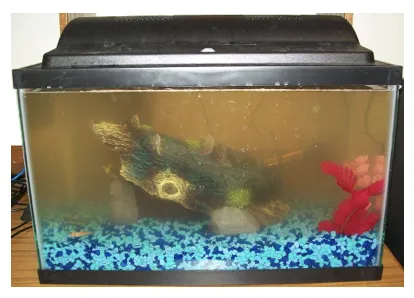Who (or what) was your first pet? I am guessing that for many of you it was some type of fish. Did you ever have a pet goldfish?
When I was a kid, it seemed like people were always giving out a gold fish in a clear plastic bag of water as the “prize” for something. I won a lot of goldfish – especially at carnivals and fairs. However, the goldfish that I brought home always seemed to die within a couple of days. Ultimately, they ended up being unceremoniously flushed down our toilet. Poor goldfish! (My poor parents!)
Let’s pretend that you have a pet goldfish. Let’s say her name is “Goldie.” Very original, huh? See her above? Isn’t she cute?
You REALLY care about Goldie; you want her to be healthy; and you want her to live a good, long life.
So, you tell Goldie not to eat too much. You teach her how to eat “healthy.” At the pet store, you buy the best natural, organic fish food for her that money can buy.
To make sure that she gets enough exercise, you train her how to swim laps while moving clockwise around her fish bowl. To make sure that she does not run into things while swimming, you also train her to not drink alcohol or text while swimming. (OK, that is stretching it a bit
You train her to get enough sleep. By 8:00 p.m. it is “lights out” at the local aquarium. Everyone in your household gets quiet, dims the lights, and goes to sleep. Ten hours of sleep per night for everyone!
You even take Goldie to all her recommended vet appointments to make sure that she gets all her wellness checks and preventive screenings.
Would any of your actions above ensure that Goldie experiences good health?
The answers is . . . (drum roll please!) . . . NO! Nothing that you said or did with Goldie would ensure that she experienced good health.
Why not?
Because the most important determinant of health for Goldie is the quality of the water in which she lives – her ecosystem.
You see, Goldie’s health is influenced MOST by her ecosystem – herbiome – the environment in which she lives. Her ecosystem includes every living organism and non-living thing. It embodies every single aspect of her habitat, including all the interactions between and among the different elements.
Just like Goldie, human beings also live in an ecosystem that includes their physical and social environments. Our ecosystem also includes every living organism, every non-living thing, and all the interactions between and among the different elements.
Every person reading this is “swimming” in an ecosystem that either supports and facilitates positive health or negative health.
These higher-level, upstream, “ecosystem-type” determinants of health (i.e., the causes of the causes of health) are FAR more powerful and impactful than lower-level, downstream variables such as knowledge, beliefs, perceptions, attitudes, behaviors, or any personal traits.

In closing, here is the clincher: The odds of people experiencing positive health and quality of life are greatly increased when multiple factors within their ecosystem support positive health.
Therefore, if you desire to help others achieve positive health and to improve their quality of life, you must become very skilled at designing interventions that positively influence multiple factors in the ecosystem of your priority population- and design them to be sustainable over time.
When we partner with our clients, we help them do just that. You can read about how to use an ecological approach when designing health programs in the next resource guide.
Call or email us today if we can help you.


